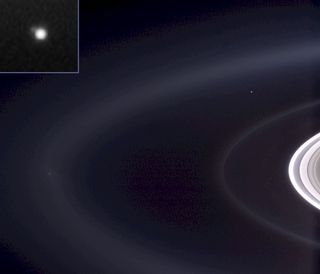How Far Away is Saturn?
The most distant of the planets obviously visible to the naked eye, Saturn is the sixth planet in the solar system. Because it travels in an elliptical path rather than a circular one, it doesn't always lie the same distance from the sun as it wanders through the sky.

How far is Saturn from Earth?
The distance to Saturn from our planet is constantly changing as both of the planets travel through space. When the two are closest, they lie approximately 746 million miles (1.2 billion kilometers) apart, or eight times the distance between the Earth and the sun. At their most distant, when they lie on opposite sides of the sun from one another, they are just over a billion miles (1.7 billion km) apart, or 11 times the distance between the Earth and the sun.
Traveling through space at more than 21,000 mph (34,000 kph), Saturn takes 29.5 Earth years to make a single orbit around the sun. Earth overtakes the gas giant in its rotation just under once a year, causing Saturn to appear to move backwards in the night sky as our planet zips by it. This retrograde motion caused a number of problems to the original, sun-centric (or "Copernican") models of the solar system, whose perfect circles did not account for the apparent loop Saturn and other planets made. It was not until Johannes Kepler determined that planets traveled in elliptical paths rather than circular ones that the problem was clarified.
How far is Saturn from the sun?
Like all of the planets, the massive gas giant Saturn travels in an ellipse rather than a circular path, and so its distance from the sun varies slightly over the course of its year. Saturn averages 886 million miles (1.4 billion km) from the sun, nine and a half times Earth's average distance. At its farthest (aphelion), Saturn hovers 934 million miles (1.5 billion km) from the sun; at its closest (perihelion), the distance to Saturn from the sun is "only" 839 million miles (1.4 billion km). Such a distance means that Saturn's temperature remains chilly year-round.
How long does it take to reach Saturn?
Space travel is rarely a matter of moving in a straight line. Spacecraft often take advantage of planets, moons, and even the sun to gain speed with the use of little fuel. As such, older missions may have taken less time to reach outer planets than those with more modern propulsion systems.
Pioneer 11 took the first look at Saturn. Launched in April 1973, the craft passed Saturn over six years later, in September 1979.
The Voyager spacecrafts took advantage of an optimal lineup to explore the outer planets. Launched in September 1977, Voyager 1 used a gravitational assist from Jupiter to swing by Saturn in November 1980, only three years after leaving Earth. Although Voyager 2 launched a month earlier than its twin, it took a longer, more circular route and arrived in August 1981, taking a full four years to reach Saturn.
The Cassini mission, which left Earth in October 1997, twice used Venus for gravitational assists, slingshoting off of the cloudy planet. It also made a flyby of Jupiter, imaging the gas giant as it passed by. After almost seven years, the craft entered orbit around Saturn in July 2004, where it intends to study the planet until at least 2017. Among other things, the mission has studied lightning in Saturn's atmosphere.
The New Horizons mission, headed to the dwarf planet Pluto, launched in January 2006. Traveling at the fastest launch speed to date, it passed by Mars and Jupiter, then skimmed by Saturn in June 2008, taking only a year and a half to reach the ringed giant.
As you can see, the question of how long it takes to reach Saturn depends significantly on the path selected for the mission, as much if not more than the speed of the spacecraft itself.
— Nola Taylor Redd, SPACE.com Contributor
Related:
Join our Space Forums to keep talking space on the latest missions, night sky and more! And if you have a news tip, correction or comment, let us know at: community@space.com.
Get the Space.com Newsletter
Breaking space news, the latest updates on rocket launches, skywatching events and more!

Nola Taylor Tillman is a contributing writer for Space.com. She loves all things space and astronomy-related, and enjoys the opportunity to learn more. She has a Bachelor’s degree in English and Astrophysics from Agnes Scott college and served as an intern at Sky & Telescope magazine. In her free time, she homeschools her four children. Follow her on Twitter at @NolaTRedd
